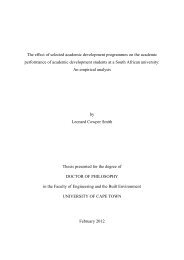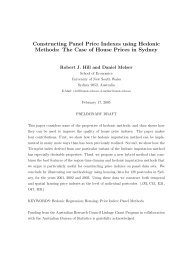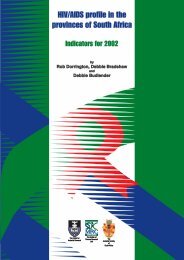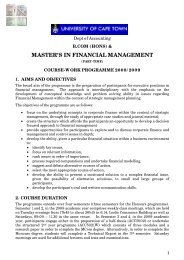Competition and Regulation in the Telecommunications Industry in ...
Competition and Regulation in the Telecommunications Industry in ...
Competition and Regulation in the Telecommunications Industry in ...
Create successful ePaper yourself
Turn your PDF publications into a flip-book with our unique Google optimized e-Paper software.
<strong>Competition</strong> <strong>and</strong> <strong>Regulation</strong> <strong>in</strong> <strong>Telecommunications</strong>• Interconnection pric<strong>in</strong>g – a long distance call must orig<strong>in</strong>ate <strong>and</strong> term<strong>in</strong>ate<strong>in</strong> a local access network. As such, <strong>the</strong> cost of <strong>in</strong>terconnection will impacton <strong>the</strong> overall cost of <strong>the</strong> long-distance call. Unless <strong>the</strong> <strong>in</strong>cumbent isvertically separated (as with AT&T), <strong>the</strong>re is a danger that <strong>the</strong> <strong>in</strong>cumbentcan set <strong>in</strong>terconnection rates at higher levels for compet<strong>in</strong>g long-distancenetworks <strong>and</strong> so raise <strong>the</strong> costs of <strong>the</strong>ir rivals. As discussed <strong>in</strong> <strong>the</strong> localaccess section, <strong>the</strong>re are also dangers of delay<strong>in</strong>g <strong>in</strong>terconnectionagreements to raise rivals costs. The o<strong>the</strong>r danger with <strong>in</strong>terconnection isthat <strong>the</strong> <strong>in</strong>cumbent offers a lower quality of connection to compet<strong>in</strong>g longdistanceproviders, mak<strong>in</strong>g <strong>the</strong>ir service less attractive to subscribers.• Facilities leas<strong>in</strong>g – as with <strong>in</strong>terconnection pric<strong>in</strong>g, <strong>the</strong> price at whichfacilities are leased will <strong>in</strong>fluence <strong>the</strong> price of rival’s costs. If <strong>the</strong> entrantneeds to lease facilities as a short-term measure, <strong>the</strong>n <strong>the</strong> price of leas<strong>in</strong>gwill be an important <strong>in</strong>fluence on average costs. It is clearly <strong>in</strong> <strong>the</strong> <strong>in</strong>terestof <strong>the</strong> <strong>in</strong>cumbent to overprice <strong>the</strong>se services. The preferable arrangementis for <strong>the</strong> leas<strong>in</strong>g price to at least reflect long run costs of provid<strong>in</strong>g <strong>the</strong>facilities. However, it is also feasible that <strong>the</strong> <strong>in</strong>cumbent price below cost <strong>in</strong>off-peak periods to get rid of excess capacity.For long-distance service providers <strong>the</strong> barriers to entry are substantially less.Service providers lease network capacity from network providers <strong>and</strong> <strong>the</strong>nresell it to subscribers on a per m<strong>in</strong>ute basis. The <strong>in</strong>frastructure <strong>the</strong>y require isa bill<strong>in</strong>g system <strong>and</strong> a switch connection to <strong>the</strong> long distance provider’s po<strong>in</strong>tof-presence(<strong>the</strong>y are routed through <strong>the</strong> local access network like all o<strong>the</strong>rs).However, service provider’s face <strong>the</strong> same customer switch<strong>in</strong>g costs ascompet<strong>in</strong>g network providers. In liberated markets <strong>the</strong> pre-select option israrely made available to service providers because of <strong>the</strong> highly contestablenature <strong>and</strong> proliferation of suppliers. Service providers also face <strong>the</strong> problemof <strong>in</strong>terconnection pric<strong>in</strong>g <strong>and</strong> facilities leas<strong>in</strong>g. The facilities leas<strong>in</strong>g is more ofa problem for service providers than network providers because <strong>the</strong>y lease allfacilities <strong>and</strong> not just where <strong>the</strong>y have not rolled out.Likelihood of entryEntry <strong>in</strong>to long distance network <strong>and</strong> service provision is highly likely <strong>in</strong> SouthAfrica if <strong>the</strong> market were liberalised. On <strong>the</strong> network side, Transtel <strong>and</strong> Esitelalready have networks <strong>in</strong> place, <strong>and</strong> <strong>in</strong>ternational network providers alreadyexist but cannot sell directly to <strong>the</strong> subscriber. Given <strong>the</strong> growth <strong>in</strong> data traffic,<strong>the</strong>re is considerable scope for o<strong>the</strong>r entrants <strong>in</strong>to <strong>the</strong> market. Open<strong>in</strong>g resale<strong>and</strong> network competition at <strong>the</strong> same time makes it highly likely that <strong>in</strong>itialcompetitors will lease facilities while <strong>the</strong>y establish <strong>the</strong>ir own networks. Thiswill accelerate <strong>the</strong> process of competition. <strong>Competition</strong> <strong>in</strong> service provision iseven more likely given <strong>the</strong> low costs of entry. However, <strong>the</strong> regulatorydecisions around facilities leas<strong>in</strong>g, customer switch<strong>in</strong>g <strong>and</strong> <strong>in</strong>terconnectioncosts will have a considerable impact on <strong>the</strong> entry of firms <strong>and</strong> <strong>the</strong> coverageof <strong>the</strong>ir networks.44
















